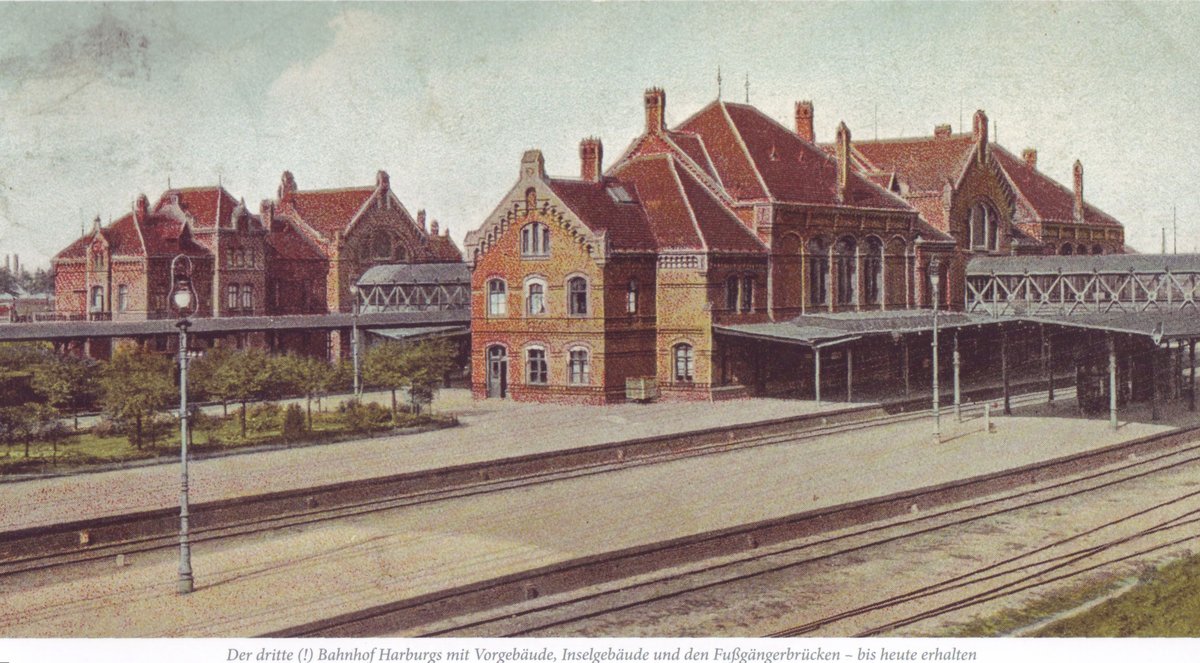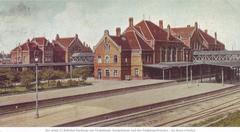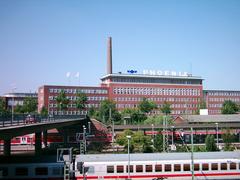
Hamburg-Harburg Station Visiting Hours, Tickets, and Travel Guide
Date: 14/06/2025
Introduction: The Gateway to Southern Hamburg
Hamburg-Harburg Station is a vital transportation hub in southern Hamburg, Germany, renowned for its rich history, architectural significance, and seamless connectivity. Originally established in 1847 and reconstructed in its iconic form in 1897 by architect Hubert Stier, the station has grown alongside Hamburg’s industrial expansion, evolving into a modern junction for local, regional, and long-distance travel (de.wikipedia.org; en.wikipedia.org).
Today, Hamburg-Harburg Station serves not only as a major transit point but also as a cultural landmark, boasting a blend of historical architecture, modern amenities, and proximity to notable attractions such as the Harburg inland port and the Alte Harburger Elbbrücke (hamburg-travel.com). This guide covers everything from the station’s history and architecture to practical visitor information, travel tips, nearby attractions, and FAQs, making it an indispensable resource for commuters, tourists, and history enthusiasts.
Contents
- Early Development and Historical Evolution
- Architectural Overview
- Practical Visitor Information
- Nearby Attractions
- Frequently Asked Questions (FAQ)
- Plan Your Visit
Early Development and Historical Evolution
Origins and Expansion
Hamburg-Harburg Station traces its beginnings to 1847, when it served the Lehrte–Harburg railway line from a modest timber-framed building. With the expansion of Hamburg’s rail network and the region’s burgeoning industry, a new station opened in 1872 near the Elbe bridges, responding to increased passenger and freight demands (de.wikipedia.org).
The 1897 Rebuild and Administrative Changes
On May 1, 1897, the current station building was inaugurated, establishing Harburg as a key railway hub and the starting point for the Lower Elbe Railway (Niederelbebahn) to Cuxhaven (en.wikipedia.org). The station’s name and status evolved as Harburg was incorporated into Hamburg through the Greater Hamburg Act in 1937, officially adopting its current name in 1938.
20th-Century Modernization and S-Bahn Integration
The arrival of the Hamburg S-Bahn in 1983 marked a pivotal modernization, with a two-track tunnel station constructed beneath the mainline platforms, significantly improving urban connectivity (en.wikipedia.org). A notable event in the station’s recent history was the 2003 cable fire in the S-Bahn tunnel, which underscored the importance of robust infrastructure and emergency preparedness (hamburgausflug.de).
Recent Renovations and Future Plans
In 2009, Hamburg-Harburg Station underwent energy-efficient renovations as part of a nationwide infrastructure program, including refurbishments of the passenger overpass and enhanced weather protection (de.wikipedia.org). Future plans outlined in the Federal Transport Infrastructure Plan 2030 include the addition of a deep-level station to further expand capacity.
Architectural Overview
Exterior and Structure
The station’s 1897 building, designed by Hubert Stier, is a striking example of late 19th-century German railway architecture. Its robust façade, arched windows, and spacious concourse reflect both the functional needs of a major railway junction and the aesthetic ideals of the industrial era (de.wikipedia.org).
Six mainline tracks serve long-distance, regional, and night trains, while the S-Bahn platforms are situated underground, accessible by elevators and escalators for efficient transfers (hamburg.com).
Heritage and Adaptive Reuse
Adjacent to the station, the preserved halls of the former railway repair works now house commercial facilities, demonstrating Hamburg’s commitment to adaptive reuse and heritage conservation. Remnants of the marshalling yard and freight areas evoke the station’s industrial past (de.wikipedia.org).
Integration with Urban and Maritime Architecture
The surrounding Harburg district features a unique blend of historic port infrastructure and modern development. Notable nearby examples include the red-brick warehouses and innovative buildings of the Harburg inland port, as well as the 19th-century steel arch Alte Harburger Elbbrücke, a favorite spot for pedestrians and cyclists (hamburg-travel.com).
Modern Amenities and Accessibility
Recent upgrades have enhanced energy efficiency and passenger comfort. The station offers elevators, ramps, tactile guidance, and weather-protected walkways, ensuring barrier-free access for all travelers (de.wikipedia.org).
Practical Visitor Information
Visiting Hours and Ticketing
- Station Hours: Open daily from approximately 4:30 AM to 1:00 AM.
- Ticketing: Purchase tickets at self-service machines (available 24/7), staffed counters during business hours, or online via bahn.com and the DB Navigator app.
- Deutschlandticket: Unlimited regional and public transit throughout Germany for €58/month (as of May 2023) is available for those planning extended stays.
Accessibility
The station is fully accessible, featuring step-free routes, elevators, tactile guidance systems, and a dedicated Mobility Service Centre for travelers with disabilities (bahnhof.de). Assistance can be arranged in advance.
Amenities
- Customer Service: DB Information desk, luggage lockers, ATMs, and free Wi-Fi.
- Food & Retail: Cafes, bakeries, convenience stores, and shops.
- Security: CCTV monitoring, Federal Police presence, and emergency call points.
- Parking & Bike Storage: Multi-story car park, secure bicycle parking, and access to bike-sharing schemes.
Travel Tips
- Allow extra time for platform transfers between S-Bahn and long-distance trains.
- Avoid peak hours (7:00–9:00 AM, 4:00–7:00 PM) for a more relaxed experience.
- Download the HVV or DB Navigator apps for real-time updates and digital ticketing.
- The Hamburg Card offers unlimited travel and discounts on local attractions.
Nearby Attractions
- Harburg Inland Port: Historic and modern waterfront development, a short walk from the station.
- Alte Harburger Elbbrücke: Scenic 19th-century steel arch bridge, open to pedestrians and cyclists.
- Harburg Castle: Medieval fortress with guided tours and regional history exhibits.
- Harburger Rathaus: Impressive historical town hall.
- Harburg City Park: A green urban oasis nearby.
For more on the area’s maritime architecture and street art, see the Cultural Route in Harburg.
Frequently Asked Questions (FAQ)
Q: What are Hamburg-Harburg Station’s opening hours?
A: The station is generally open from 4:30 AM to 1:00 AM, with public access to platforms and amenities during these times.
Q: How do I purchase tickets?
A: Tickets are available from self-service machines, staffed counters, or online via bahn.com and the HVV app.
Q: Is the station accessible for travelers with disabilities?
A: Yes, the station provides elevators, ramps, tactile guidance systems, and a Mobility Service Centre.
Q: Are guided tours available?
A: While the station does not offer official tours, local heritage organizations occasionally host guided tours. Check the Hamburg Heritage Society for updates.
Q: What are some nearby attractions?
A: Harburg Castle, Harburg Rathaus, the inland port, and Alte Harburger Elbbrücke are all within easy reach.
Q: How do I reach Hamburg-Harburg Station from central Hamburg?
A: The station is served by S-Bahn lines S3 and S31, as well as regional and long-distance trains.
Plan Your Visit
Hamburg-Harburg Station is more than just a transit point—it is a living testament to Hamburg’s industrial and urban heritage, offering modern comfort and efficient connectivity. For up-to-date schedules, ticket information, and accessibility details, visit the official Deutsche Bahn website or download the DB Navigator app.
Visitors are encouraged to explore nearby attractions, take advantage of digital travel resources, and consider the Deutschlandticket for regional travel. For cultural and historical insights, consult the Hamburg Heritage Society or join a walking tour of the Harburg district.
Download the Audiala app for real-time updates, audio guides, and exclusive content about Hamburg-Harburg Station and its surroundings.
Visuals and Media

Alt text: Exterior view of Hamburg-Harburg Station showcasing its historic façade.

Alt text: Red-brick warehouses and waterfront at Harburg Inland Port near Hamburg-Harburg Station.
Interactive maps and further resources are available on the official Hamburg website.
Call to Action
Discover the unique blend of history, architecture, and modern transport at Hamburg-Harburg Station. Plan your visit today to experience one of Hamburg’s most important urban gateways, and explore the rich cultural landscape of the Harburg district.
- For official station details: bahnhof.de
- For local tours and history: Hamburg Heritage Society
- For public transport: HVV Public Transport
Internal Links:
References and Sources
- Bahnhof Hamburg-Harburg, Wikipedia (DE)
- Hamburg-Harburg Station, Wikipedia (EN)
- Hamburgausflug: History, Visiting Hours, Tickets, and Nearby Attractions
- Hamburg.com: Station Overview
- Hamburg Travel: Maritime Architecture and Street Art in Harburg
- Deutsche Bahn Official Site





















































































